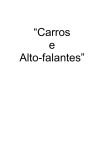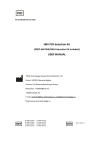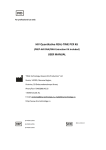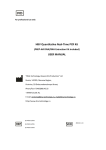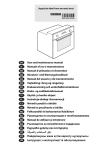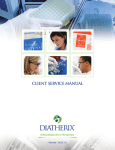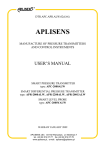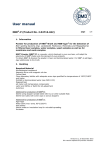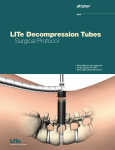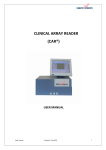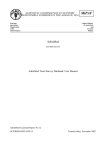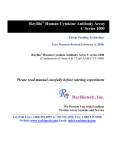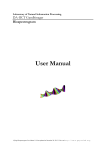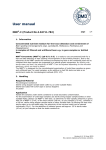Download The FEMOFLOR® Real
Transcript
The FEMOFLOR® Real-Time PCR Kit
Available supply options:
FEMOFLOR®-16 (12 tests)
FEMOFLOR®-8 (24 tests)
FEMOFLOR®-4 (48 tests)
The manual has approved:
General Director "DNA-Technology, Research & Production" LLC Dmitrovskiy Vladimir.
The version: 260-1bel. Date of the statement: 30.09.2013
Read entire protocol before use
1
2
1. Introduction
The FEMOFLOR® Real-time PCR Kit is a qualitative in vitro nucleic acid test.
The FEMOFLOR® assay includes following steps:
-DNA extraction
-Real-time PCR and analysis
The extraction procedure can be performed with “DNA-Technology” extraction kits (see
current manual for the reference) or appropriate third-party extraction kits.
The implemented PCR method is based on amplification of a target DNA sequence. DNA
molecules are heat denatured while the cyclic amplification program proceeds. Targetspecific primers bind to the denatured DNA templates in the presence of dNTP’s, and Taqpolymerase. Taq-polymerase extends the primers thus providing the synthesis of
complementary DNA chains and amplification of target DNA sequence.
To increase the specificity and sensitivity of reaction, a paraffin layer separates the PCR-mix
and Taq-polymerase. It hampers the admixture of PCR components at low temperatures,
thus providing a “hot-start” feature which prevents unspecific PCR.
Real-time PCR technology is based on measurement of fluorescence at every cycle of
reaction. The PCR-mix contains target-specific hydrolyzing probes bearing reporter and
quencher molecules. While the probe is intact, these molecules are close enough to provide
effective quenching. Once hybridized to a target sequence, the probe is hydrolyzed by Taqpolymerase. Thereby reporter and quencher become separated and fluorescence increases
proportionally to target sequence amplification. The intensity of fluorescence is analyzed
with a Real-time PCR instrument data collection unit and the software provided.
The fluorescent dyes are assigned to individual types of sequences. The FAM dye label is
used to detect specific sequences. The HEX dye label is used to detect SIC and IC (see
tables 1,2,3 for the reference). Use of two distinguishable dyes allows detection of both PCR
products simultaneously.
Defined tubes contain additional probe with ROX dye label – “Marker” (see tables 1,2,3 for
the reference). It tags the strip orientation. Upon completion of run, software defines actual
position of the strip (by means of “marker” position) relative to the position preset by the
operator. If it mismatches, the software suggests rearrangement of the tubes by default. In
accordance with the operator, order can be rearranged and saved in new file.
The “DNA-Technology” DTlite*, DTprime** or DT-96 thermal cyclers are required to run the
FEMOFLOR® Real-time PCR’s.
Upon completion of the run, software performs relative quantitative analysis of total
bacterial DNA, genus-specific DNA of Lactobacillus spp. and genus/species-specific DNA of
each the opportunistic pathogens (or flora) according to kit format (see tables 1,2,3 for the
reference). To exclude false negatives, human DNA (SIC) quantity is considered.
2. Intended use
-The FEMOFLOR® Real-time PCR Kit is intended for research and diagnostic
applications.
-The DNA-Technology FEMOFLOR® Real-time PCR Kit is intended for the study of
vaginal microbiocenosis.
-The FEMOFLOR® Real-time PCR Kit is designed to detect the DNA of opportunistic
pathogens (see tables 1,2,3 for the reference), DNA of Lactobacillus sp., and human
genomic DNA (sample intake control, SIC).
_________________________________________________________________
* - supported by 4S1; 4S2; 5S1; 5S2; 6S1; 6S2 instruments.
** - supported by 4M1; 4M3; 4M6; 5M1; 5M3; 5M6; 6M1; 6M3; 6M6 instruments.
3
3. Contents
Paraffin sealed PCR-mix including:
-PCR-mix for total bacterial DNA amplification.
-PCR-mix for genus-specific amplification of Lactobacillus spp. DNA
-PCR-mix for genus/species-specific amplification of opportunistic flora DNA
- Taq-polymerase solution
- Mineral oil
- Positive control
FEMOFLOR®-4 is used to perform 48 tests, including positive and negative controls. This kit
provides 7 estimates, including 5 groups of bacteria, SIC and total bacterial DNA.
The FEMOFLOR® Real-time PCR Kit is available in three formats depending on the
arrangement of microorganisms to be detected.
FEMOFLOR®-8 is used to perform 24 tests, including positive and negative controls. The kit
provides 11 estimates, including 9 groups of bacteria, SIC and total bacterial DNA.
FEMOFLOR®-16 is used to perform 12 tests, including positive and negative controls. This
kit provides 25 estimates, including 23 groups of bacteria, SIC and total bacterial DNA.
The
FEMOFLOR®
Real-time
PCR
Kit
chemistry/detection channels, color tags.
Table 1
FEMOFLOR®-4
formats,
contents,
fluorescent
Dye label/detection channel
№ of vial
in a strip
Fam
Hex
Rox
Color of
buffer
1, 5
total bacterial DNA
-
-
Blue
2, 6
Lactobacillus spp.*
IC
-
3, 7
Gardnerella
vaginalis/
Prevotella bivia/
Porphyromonas spp.
-
-
4, 8
Candida spp.
SIC
Marker
Color of
paraffin
White
4
Colorless
Table 2
FEMOFLOR®-8
№ of vial
in a strip
Fam
Hex
Rox
Color of
buffer
1
total bacterial DNA
-
-
Blue
2
Lactobacillus spp.
IC
-
3
Enterobacterium spp.
-
-
Dye label/detection channel
White
Colorless
4
Streptococcus spp.
-
-
5
Gardnerella
vaginalis/
Prevotella bivia/
Porphyromonas spp.
-
-
6
Eubacterium spp.
-
-
7
Mycoplasma hominis
Mycoplasma
genitalium
-
8
Candida spp.
SIC
Marker
5
Color of
paraffin
Table 3
FEMOFLOR®-16
Dye label/detection channel
Hex
Strip-1
№ of vial
in a strip
Fam
1
total bacterial DNA
-
-
2
Lactobacillus spp.
IC
-
3
Enterobacterium spp.
-
-
4
Streptococcus spp.
-
-
Rox
Color
buffer
of
Color
paraffin
Blue
White
5
Staphylococcus spp.
-
Marker
6
Gardnerella
vaginalis/
Prevotella bivia/
Porphyromonas spp.
-
-
7
Eubacterium spp.
-
-
8
Sneathia spp./
Leptotrihia spp./
Fusobacterium spp.
-
-
6
Colorless
of
Table 3
FEMOFLOR®-16
№ of vial
in a strip
Dye label/detection channel
Fam
Hex
Rox
Color
buffer
of
Color
paraffin
of
Strip-2
1
Megasphaera spp./
Veilonella spp./
Dialister spp.
-
-
2
Lachnobacterium
spp./ Clostridium
spp.
-
-
3
Mobiluncus spp./
Corynebacterium
spp.
-
-
4
Peptostreptococcus
spp.
-
-
Blue
Blue
5
Atopobium vaginae
-
-
6
Mycoplasma hominis
Mycoplasma
genitalium
-
7
Ureaplasma
(urealyticum +
parvum)
-
-
8
Candida spp.
SIC
Marker
Colorless
4. Warnings and precautions
As part of industrial and personal hygiene and general safety practices, avoid all
unnecessary exposure to the chemical components of this kit and ensure prompt removal
from skin, eyes, and clothing upon contact.
Significant health effects are NOT anticipated from routine use of this kit when adhering to
the instructions listed in the current manual.
4.1 General warnings and precautions
Handle and dispose all biological samples as if they were able to transmit infective agents.
7
Avoid direct contact with the biological samples. Avoid producing spills or aerosol. Any
material coming in contact with the biological samples must be treated for at least 30
minutes with disinfecting solution or autoclaved for 1 hour at 121ºC before disposal.
Handle and dispose all reagents and all materials used to carry out the assay as if they were
able to transmit infective agents. Avoid direct contact with the reagents. Avoid producing
spills or aerosol. Waste must be handled and disposed according to adequate safety
measures. Disposable combustible material must be incinerated. Liquid waste containing
acids or bases must be neutralized before disposal.
Wear suitable protective clothes and gloves and protect eyes and face
Never pipette solutions by mouth
Do not eat, drink, smoke or apply cosmetic products in the work areas
Carefully wash hands after handling samples and reagents
Dispose of leftover reagents and waste in compliance with the regulations in force.
Read the User manual provided with the kit before running the assay
While running the assay follow the instructions listed in the User manual
Do not use the kit after the expiry date provided
Only use the reagents provided in the kit and those recommended by manufacturer
Do not mix reagents from different batches
Do not use reagents from third party manufacturers’ kits
4.2 Warnings and precautions for molecular biology
Molecular biology procedures, such as nucleic acids extraction, reverse transcription,
amplification and detection require qualified staff to avoid the risk of erroneous results,
especially due to the degradation of nucleic acids contained in the samples or sample
contamination by amplification products.
Equip separate areas for the extraction/preparation of amplification reactions and for the
amplification/detection of amplification products. Never introduce an amplification product in
the area designed for extraction/preparation of amplification reactions.
Wear lab coats, gloves and tools, which are exclusively employed for the
extraction/preparation of the amplification reaction and for the amplification/detection of the
amplification products. Never transfer lab coats, gloves and tools from the area designed for
amplification/detection of the amplification products
to the area designed for
extraction/preparation of amplification reactions.
The samples must be exclusively employed for certain type of analysis. Samples must be
handled under a laminar flow hood. Tubes containing different samples must never be
opened at the same time. Pipettes used to handle samples must be exclusively employed
for this specific purpose. The pipettes must be of the positive dispensation type or be used
with aerosol filter tips. The tips employed must be sterile, free from the DNases and
RNases, free from DNA and RNA.
8
The reagents must be handled under a laminar flow hood. The reagents required for
amplification must be prepared in such a way that they can be used in a single session.
Pipettes used to handle reagents must be exclusively employed for this specific purpose.
The pipettes must be of the positive dispensation type or be used with aerosol filter tips.
The tips employed must be sterile, free from the DNases and RNases, free from DNA and
RNA.
Amplification products must be handled in such a way as to reduce dispersion into the
environment as much as possible, in order to avoid the possibility of contamination. Pipettes
used to handle amplification products must be exclusively employed for this specific
purpose.
4.3 Emergency actions
Inhalation: Inhalation of the Master Mix contained within this kit is unlikely, however care
should be taken.
Eye Contact: If any component of this kit enters the eyes, wash eyes gently under potable
running water for 15 minutes or longer, making sure that the eyelids are held open. If pain
or irritation occurs, obtain medical attention.
Skin Contact: If any component of this kit contacts the skin and causes discomfort,
remove any contaminated clothing. Wash affected area with plenty of soap and water. If
pain or irritation occurs, obtain medical attention.
Ingestion: If any component of this kit is ingested, wash mouth out with water. If
irritation or discomfort occurs, obtain medical attention.
5. Instruments and materials required
The following instruments and materials are required when using FEMOFLOR® Real-time
PCR Kit:
Real-time PCR thermal cycler (the optical, thermal and engine calibrations of DTlite,
DTprime and DT-96 thermal cyclers are non-customizable. The instruments are
calibrated on manufacturing facility in accordance with internal quality control
regulations. The calibration information and settings for each instrument can be
obtained from “DNA-Technology” customer service by request. The validation of
the adjustable parameters should be performed in accordance with corresponding
User manual);
High speed centrifuge (13000 rpm);
Microcentrifuge;
Refrigerator;
Thermostat (temperature range 50-65 °C);
PCR tube rack for 1.5 ml tubes;
PCR tube rack for strips of eight 0.2 ml tubes;
1.5 ml PCR tubes;
Single channel pipettes (volume range 0.5-10 μl, 5-40 μl, 40-200 μl, 100-1000 μl);
RNase and DNase free filtered pipette tips (volume range 20 μl, 50 μl, 200 μl,
1000 μl);
Powder-free surgical gloves;
Disinfectant solution;
Physiological saline solution 0.9% NaCl (Sterile);
Container for used pipette tips;
Nucleic acid extraction kit (DNA-Technology PROBE NA-PLUS® or PROBE GS-PLUS®
are recommended).
Software: The recommended version of software is 7.3.5.84*, software older than version
7.3.3.10 is not recommended; “Femoflor.ini” file.
_________________________________________________________________
* - the recommended version can be changed due to software update.
The recent version of DT-96 software is available for download at http://www.dnatechnology.ru/support
9
6. Samples
A sample of epithelial cells is taken from the urethra, cervix, or posterolateral vaginal wall
depending on professional prescription.
Sampling, processing, and storage of samples is held in accordance to PROBE NA-PLUS® or
PROBE GS-PLUS® instruction.
6.1 Sampling procedure
Sampling is carried out by scraping of epithelial cells from respective biotope. The urogenital
sampling is held by sterile swab (or brush). The sample is then transferred to plastic tubes
containing 300 μl of physiological saline solution or in the tubes containing DNA-Technology
PROBE-RAPID® solution.
6.1.1. General requirements
To interpret results successfully and robustly, a high quality of sample and appropriate
conditions of storage, transport, and handling are required.
6.1.2. Material
Professional prescription is required to localize the place of sampling (urethra, cervix or
vaginal wall). The decision must be based on a patient’s complaints and clinical signs, and
made by the physician in charge.
Women must not perform hygiene procedures or syringing prior the sampling procedure.
To interpret results successfully and robustly, sample must contain the largest possible
number of epithelial cells with minimum amounts of mucus and blood. Inappropriate
sampling may result in doubtful results and sample collection may need to be repeated.
6.1.3 The features of vaginal sampling
The sample must be taken prior to physical inspection. Speculum can be treated by warm
water before the procedure. Antiseptics must not be used for speculum treatment. The
sample is taken from the lateral or posteroinferior vaginal wall.
From virginal women, sample must be taken from the entrance of vagina, or in special cases
from the posterior vaginal wall through the hymenal ring.
6.1.4 The features of urethral sampling
Patient must not urinate within 1.5-2 hours prior to sampling procedure.
The external urethral orifice must be treated with a swab moistened with sterile
physiological saline solution just prior to the sampling procedure.
In the case of purulent discharge, the sample must be taken 15-20 minutes after urinating.
In the absence of discharge, it is necessary to massage urethra with sampling swab or
brush.
Carefully insert the swab into the woman’s urethra to a depth of 1-1.5 cm. A child’s sample
must be taken from the external urethral orifice.
6.1.5 The features of cervical sampling
Remove mucus with a swab prior to sampling, and treat the cervix with sterile physiological
saline solution.
Carefully insert sampling swab into the cervix to a depth of 0.5-1.5 cm
Avoid contact with vaginal wall when removing the swab
6.1.6 Guidelines for taking sample to transport medium
6.1.6.1 Open the tube
6.1.6.2 Scrape epithelial cells from the corresponding biotope (i.e.,vagina, urethra, cervix)
with a sterile swab. Put the swab into the tube with transport medium and rinse it
thoroughly. Avoid spraying of solution. Remove swab from solution, press it to the wall of
tube and squeeze the rest of the liquid. Throw out the swab. Use a new swab if you need to
repeat sampling or to take sample from another biotope.
6.1.6.3 Close the tube tightly and mark it.
6.2 Transport and storage of sample
ATTENTION
Overall time from the sample intake until analysis must not exceed 24 hours.
10
Store samples at 2-8 °C.
If sample cannot be delivered to laboratory within 24 hours, it can be frozen once.
7. Overview of the analysis procedure
7.1 DNA isolation
IMPORTANT: A DNA isolation kit is not included in FEMOFLOR® Real-time PCR Kit.
If the sample is taken in a tube with sterile physiological saline solution, PREP-NA-PLUS or
PREP-GS-PLUS kits are recommended for DNA isolation. If the sample is taken in a tube
from the PREP-RAPID kit, PREP-NA-PLUS kit is recommended for DNA isolation.
Enquire with customer service about compatibility of third-party DNA isolation kits with
FEMOFLOR® Real-time PCR Kit.
Regardless of the kit used for DNA isolation, a negative control (blank sample that passed
all stages of DNA isolation procedure) must be prepared.
7.1.1. Isolation of DNA from urogenital samples using PREP-NA-PLUS kit.
Note: If precipitate occurs in the “Lysis Solution”, dissolve it by heating solution up to 65 °C
for 10 minutes prior to use. Use RNase and DNase-free pipette tips only.
7.1.1.1. Centrifuge the tubes with samples at 13000 rpm for 10 minutes.
7.1.1.2. Remove supernatant, leaving approximately 100 µL of liquid (precipitate+liquid
fraction).
IMPORTANT: Perform each step of DNA isolation procedure for negative control ("C-") in
parallel with test samples. Add 100 µL of negative control in a new 1.5 ml tube and perform
the procedure according to par. 7.1.1.3-7.1.1.18 of current manual.
7.1.1.3. Add 300 µl of Lysis Solution into each tube. Avoid contact of pipette tip with the
edges of the tube.
7.1.1.4. Close the tubes tightly. Vortex the tubes for 3-5 seconds.
7.1.1.5. Incubate the tubes at 65 °C for 15 minutes. Centrifuge the tubes at 13000 rpm for
30 seconds to precipitate condensate.
7.1.1.6. Add 400 µL of Precipitation Reagent into the tubes and vortex the tubes for 3-5
seconds.
7.1.1.7. Centrifuge the tubes at 13000 rpm for 15 minutes.
7.1.1.8. Remove supernatant completely. Avoid contact of pipette tip with pellet (use new
tip for each tube).
7.1.1.9. Add 500 µl of Wash Solution №1 to the pellet and shake the tube 3-5 times gently.
7.1.1.10. Centrifuge the tubes at 13000 rpm for 15 minutes.
7.1.1.11. Remove supernatant completely. Avoid contact of pipette tip with pellet (use new
tip for each tube).
7.1.1.12. Add 300 µl of Wash Solution №2 to the pellet and shake the tube 3-5 times
gently.
7.1.1.13. Centrifuge the tubes at 13000 rpm for 5 minutes.
7.1.1.14. Remove supernatant completely. Avoid contact of pipette tip with pellet (use new
tip for each tube).
7.1.1.15. Open the tubes and dry the pellet at 65 °C for 5 minutes.
7.1.1.16. Add 300 µl of Dilution Buffer to the pellet. Centrifuge the tubes for 3-5 seconds to
collect drops.
7.1.1.17. Incubate the tubes at 65 °C for 10 minutes. Vortex the tubes for 3-5 seconds.
7.1.1.18. Centrifuge the tubes for 30 seconds at 13000 rpm to collect drops.
11
DNA sample is ready to use in the PCR reaction.
Store the DNA sample at -20 C for one month or at -70 C for one year.
7.1.2. Isolation of DNA from urogenital samples using PREP-GS-PLUS kit.
Note: If precipitates occur in the “Lysis Solution” or Wash solution №1 dissolve it by heating
solution up to 50 °C for 15-20 minutes prior to use. Use RNase and DNase-free pipette tips
only.
7.1.2.1. Centrifuge the tubes with samples at 13000 rpm for 10 minutes.
7.1.2.2. Remove supernatant, leaving approximately 100 µL of liquid (precipitate+liquid
fraction).
IMPORTANT: Perform each step of DNA isolation procedure for negative control ("C-") in
parallel with test samples. Add 100 µL of negative control in new 1.5 ml tube and perform
the procedure according to par. 7.1.2.3-7.1.2.21 of current manual.
7.1.2.3. Mix Lysis Solution with the Sorbent in a separate tube as follows:
150x(N+1) µl of Lysis Solution
20x(N+1) µl of previously resuspended Sorbent
(N+1)- number of samples to be analyzed including “C-”(N) and one reserve
sample.
7.1.2.4. Add 170 µl of prepared mixture into each tube.
7.1.2.5. Close the tubes tightly, vortex the tubes for 3-5 seconds.
7.1.2.6. Incubate the tubes at 50 °C for 20 minutes.
7.1.2.7. Centrifuge the tubes at 13000 rpm for 1 minute.
7.1.2.8. Remove supernatant completely. Avoid contact of pipette tip with pellet (use new
tip for each tube).
7.1.2.9. Add 200 µl of Wash Solution №1 to the pellet. Vortex the tubes for 3-5 seconds.
7.1.2.10. Centrifuge the tubes at 13000 rpm for 1 minute.
7.1.2.11. Remove supernatant completely. Avoid contact of pipette tip with pellet (use new
tip for each tube).
7.1.2.12. Add 200 µl of Wash Solution №2 to the pellet. Vortex the tubes for 3-5 seconds.
7.1.2.13. Centrifuge the tubes at 13000 rpm for 1 minute.
7.1.2.14. Remove supernatant completely. Avoid contact of pipette tip with pellet (use new
tip for each tube).
7.1.2.15. Add 200 µl of Wash Solution №3 to the pellet. Vortex the tubes for 3-5 seconds.
7.1.2.16. Centrifuge the tubes at 13000 rpm for 1 minute.
7.1.2.17. Remove supernatant completely. Avoid contact of pipette tip with pellet (use new
tip for each tube).
7.1.2.18. Open the tubes and dry the pellet at 50 °C for 5 minutes.
7.1.2.19. Add 300 µl of Elution Buffer to the pellet. Vortex the tubes for 5-10 seconds.
7.1.2.20. Incubate the tubes at 50°C for 5 minutes.
7.1.2.21. Centrifuge the tubes at 13000 rpm for 1 minute.
DNA sample is ready to use in the PCR reaction.
Store DNA samples at 2-8 °C up to 7 days. Repeat steps according to par. 7.1.2.20-7.1.2.21
of current protocol prior to use of DNA sample in PCR.
7.2 Amplification
7.2.1. Mark strips with paraffin sealed PCR-mix for test samples, positive control (C+) and
negative control (C-).
NOTE:
One strip of FEMOFLOR®-4 is used for the test of two samples
One strip of FEMOFLOR®-8 is used for the test of one sample
12
Two strips of FEMOFLOR®-16 are used for the test of one sample
Example: To analyze 2 samples mark:
-2 strips – 1 for the samples and 1 for positive and negative controls, when using
FEMOFLOR®-4.
-4 strips – 2 for the samples, 1 for positive control and 1 for negative control, when using
FEMOFLOR®-8.
-8 strips – 4 for the samples, 2 for positive controls and 2 for negative controls, when using
FEMOFLOR®-16.
See table 4 for reference.
Table 4
FEMOFLOR®-4
FEMOFLOR®-8
FEMOFLOR®-16
Sample 1
Tubes 1-4
Tubes 1-8
Tubes 1-8
strip-1 and strip2
Sample 2
Tubes 5-8
Tubes 1-8
Tubes 1-8
strip-1 and strip2
C+
Tubes 1-4
Tubes 1-8
Tubes 1-8
strip-1 and strip2
C-
Tubes 5-8
Tubes 1-8
Tubes 1-8
strip-1 and strip2
7.2.2. Mix the Taq-polymerase solution thoroughly (3-5 sec), then spin briefly (1-3 sec).
7.2.3. Aliquot 10 μl of Taq-polymerase solution into each tube. Avoid paraffin layer break.
7.2.4. Aliquot 20 μl of mineral oil (one drop from 100-1000 μl tip approximately) into each
tube. Close strips tightly.
7.2.5. Open the tube of a strip, add DNA sample, then close the tube before proceeding to
the next DNA sample to prevent contamination. Use filter tips.
Aliquot 5.0 μl of DNA sample into each tube of a strip assigned to test samples.
7.2.6 Add 5.0 μl of positive control and negative control (see par. 7.1 for reference) into
corresponding tubes.
7.2.7 Spin strips briefly (1-3 sec.)
7.2.8 Set strips to Real-time PCR instrument. Try to place tubes in the center of the
thermoblock.
7.2.9 Launch “RealTime PCR” application. Upload the corresponding test (FEMOFLOR®-4,-8
or -16) from *ini file before the first run (see par. 7.3 for reference). Add FEMOFLOR®-4,-8
or -16 test in subsequent runs (see par. 7.4 for reference). Set number of samples and
specify tubes including negative and positive controls. Specify position of strips in a
thermoblock (see par. 7.4.5 for reference). Run PCR. Refer to table 5 for the cycling
program corresponding to FEMOFLOR®-4,-8 and -16 tests. This program is displayed in a
“start program” window.
13
Table 5. DTlite, DTprime and DT-96 cycling program
Optical
data
collection
mode
№ of
block
Temperature,
°С
min
sec
Number
of cycles
Type of
block
1
80.0
94.0
0
1
30
30
1
2
94.0
64.0
0
0
30
15
5
3
94.0
64.0
0
0
10
15
45
4
94.0
0
5
1
Cycle
5
10.0
…
…
Storage
Storage
Cycle
√
√
Cycle
Cycle
Note. You can also use the «femoflor» amplification program.
7.3 FEMOFLOR®-4,-8 or -16 test upload procedure. The following procedure is
applicable for DTlight, DTprime and DT-96 Real-time PCR machines and must be held prior
to first PCR run on a given computer.
Software : version 7.3.3.10. or higher 7.3.5.84*. Software older than version 7.3.3.10 is
not recommended *.
Note. The screenshots are taken from 7.3.3.10, 7.3.4.0, 7.3.4.2, 7.3.6.11 versions.
FEMOFLOR®-4,-8 or -16 test for use with DTlight, DTprime and DT-96 Real-time PCR
machines is provided by FEMOFLOR® Real-time PCR Kit manufacturer. The upload and
synchronization procedure must be held in a “Work with device” mode as follows:
7.3.1. Launch RealTime_PCR application. Choose operator to work with FEMOFLOR® Realtime PCR Kit. Set “Work with device” mode.
Select directory for saving the data when adding new operator.
7.3.2. Select “Copy groups of tests” bookmark in the “Test” menu.
7.3.3. Select line “from *ini file” in the left module of “Copy groups of tests” window. Open
“Femoflor.ini” file.
7.3.4. Select operator whose directory will be used to copy FEMOFLOR®-4,-8 or -16 tests in
a right module of “Copy groups of tests” window.
7.3.5. Click ‘arrow’ button. The selected test will appear in a right module of window.
_________________________________________________________________________
* - the recommended version can be changed due to software update. The current version
is available for download at http://www.dna-technology.ru/support
14
The operator for whom the test was copied can work now with FEMOFLOR®-4,-8 or -16
test.
7.4. Routine work with FEMOFLOR®-4,-8 or -16 test
7.4.1. Launch RealTime_PCR application. Choose operator for whom the test was copied
(see par.7.3.4). Set “Work with device” mode.
7.4.2. Click “Add test” button.
15
7.4.3. Choose FEMOFLOR®-4,-8 or -16 test from the drop down menu.
7.4.4. Specify number of samples. Click “OK” button.
16
7.4.5.
Specify tubes. Define position of strips in software interface according to
position they were set in thermoblock (use “Clear the field” and “order fill”–
7.4.6.
7.4.7.
7.4.8.
7.4.9.
buttons).
Click “Apply” button in the lower-right corner of the “Protocol” window.
The cycling program will be displayed in “Start program” window.
Click “Start program” button in the lower-right corner of the window
Write the name of file and specify directory to save the data. The data will be saved
17
to the operator’s working directory by default (see par.7.3.1.)
8. Data collection
The optical unit of the Real-time PCR machine collects data automatically as the cycling
program proceeds.
The Real-time PCR machine detects and interprets results automatically.
Upon completion of the run, a status screen will be displayed and the operator will be
prompted to proceed to analysis. (User manual, Chapter 1 “Operation” par. 4.6)
***Type of sample, each test result (measure of quantity and diagram allowing a relative
comparison of normal flora and opportunistic pathogens in each sample) will be displayed in
the right module of the window. A qualitative analysis will be performed for pathogenic
bacteria. The resulting graph will display the dependence of fluorescence intensity on cycle
number for each tube. Operator can create, save and print a report by clicking “Report”
button
.
Open instrument panel
, select “Reports”
to create special report.
18
and select “Special biocenosis report”
9. Data analysis
9.1. The software analyzes data automatically. Software is provided by DTlite, DTprime and
DT-96 Real-time PCR machine manufacturer.
9.2. Upon completion of the run, software compares actual position of the strip (by mean of
ROX dye label position) relative to position predefined by the operator. If there is a
mismatch, the software suggests rearrangement of the tubes by default. In accordance with
the operator, order can be rearranged. If the operator does not accept rearrangement,
modified data can be saved in a new file.
9.3. The quantitative measure (logarithm of concentration) and diagram are displayed in the
line with taxonomic identifier of bacteria detected by FEMOFLOR® Real-time PCR Kit.
9.4. SIC and IC values must be considered when analyzing results:
9.4.1. SIC values lower than 4.0 should be considered as due to an insufficient amount of
sample (see par. 3.2.), and the sampling procedure must be repeated.
9.4.2. IC values lower than 3.5 should be considered as false due to PCR inhibition. PCR,
DNA extraction, or sampling procedure must be repeated.
9.5. The quantity of DNA (logarithm of concentration) in positive controls must be higher
than 4.0. The qualitative test for Mycoplasma genitalium must be positive and signed as “+”
in corresponding line of the table. If the quantity of DNA in positive controls is lower than
4.0 and the qualitative test for Mycoplasma genitalium is negative (“-“), all results of
corresponding lot should be considered as false. All samples must be reanalyzed.
9.6. The quantity of DNA (logarithm of concentration) in negative controls must not exceed
values shown in table 6. If measured amount exceeds these values, all results of the
corresponding lot should be considered as false and the PCR laboratory must be
decontaminated.
19
Table 6
Maximum acceptable amount of bacterial DNA in negative controls
FEMOFLOR®–16
№
1
2
3
4
5
6
7
8
9
10
11
12
13
14
15
16
17
Acceptable quantity of DNA
in «К-», Lg (?)
Identifier
Total bacterial DNA
Lactobacillus spp.
Enterobacterium spp.
Streptococcus spp.
Staphylococcus spp.
Gardnerella vaginalis/Prevotella
bivia/Porphyromonas spp.
Eubacterium spp.
Sneathia spp./Leptotrihia spp./Fusobacterium
spp.
Megasphaera spp./Veilonella spp./Dialister spp.
Lachnobacterium spp./Clostridium spp.
Mobiluncus spp./Corynebacterium spp.
Peptostreptococcus spp.
Atopobium vaginae
Mycoplasma hominis/Mycoplasma genitalium
Ureaplasma (urealyticum + parvum)
Candida spp.
SIC
Less
Less
Less
Less
Less
Less
than
than
than
than
than
than
3.5
2.5
2.5
2.5
2.5
2.5
Less than 2.5
Less than 2.5
Less than 2.5
Less than 2.5
Less than 2.5
Less than 2.5
Negative
negative/negative
Negative
Less than 3.0
Negative
FEMOFLOR®–8
№
1
2
3
4
5
6
7
8
9
Identifier
Acceptable quantity of DNA
in «К-», Lg (?)
Total bacterial DNA
Lactobacillus spp.
Enterobacterium spp.
Streptococcus spp.
Gardnerella vaginalis/Prevotella
bivia/Porphyromonas spp.
Eubacterium spp.
Mycoplasma hominis/Mycoplasma genitalium
Candida spp.
SIC
Less than 3.5
Less than 2.5
Less than 2.5
Less than 2.5
Less than 2.5
Less than 2.5
negative/negative
Less than 3.0
Negative
FEMOFLOR®–4
№ Identifier
Acceptable quantity (?)of
DNA in «К-», Lg
1
2
3
Less than 3.5
Less than 2.5
Less than 2.5
4
5
Total bacterial DNA
Lactobacillus spp.
Gardnerella vaginalis/Prevotella
bivia/Porphyromonas spp.
Candida spp.
SIC
Less than 30
negative
20
10. Storage and handling requirements
10.1 Expiry date – 9 month from the date of production
10.2 All components of FEMOFLOR® Real-time PCR Kit must be stored at 2-8°C over the
storage period.
10.3 Transportation can be held by all types of roofed transport at 2-8°C over the storage
period.
10.4 An expired FEMOFLOR® Real-time PCR Kit must not be used.
10.5 We strongly recommend following the instructions to get robust and reliable results.
10.6 The conformity of FEMOFLOR® Real-time PCR Kit to the prescribed technical
requirements is subject to compliance of storage, carriage and handling conditions
recommended by manufacturer.
Contact our customer service by quality issues of FEMOFLOR® Real-time PCR Kit:
115587, Moscow, Varshavskoye sh. 125g building 6, DNA Technology
Phone/Fax: +7(495)9804555
Technical support: +7 (800) 200-75-15, E-mail: [email protected],
www.dna-technology.ru
11. Quality policy
“DNA-Technology, Research&Production” LLC established the following goals to realize its
quality policy focused on “customer satisfaction management” by improving the quality
management system to comply with ISO9001:2000 and ISO13485:2003:
- observation of quality management in manufacturing of IVDD products
- creation of values for customers
- maintenance of the best service quality and customer management
12. The project of samples of marks CE
21
22
Manufacturer: "DNA-Technology, Research & Production" LLC
Russia, 142281, Moscow Region,
Protvino, 20 Zheleznodorozhnaya Street,
Phone/fax: +7(4967) 31-06-70
E-mail: [email protected]
http://www.dna-technology.ru
Seller: "DNA-Technology" LLC
Russia, 117587, Moscow
125Zh, Varshavskoe highway, bld. 6
Phone/fax: +7(495) 980-45-55
E-mail: [email protected]
Authorized representative in EU:
OBELIS S.A
Registered Address:
Bd. Général Wahis, 53
1030 Brussels,
Belgium
Tel: +32.2.732.59.54
Fax: +32.2.732.60.03
E-mail: [email protected]
http://www.obelis.net
The version: 260-1bel. Date of the statement: 30.09.2013
23























